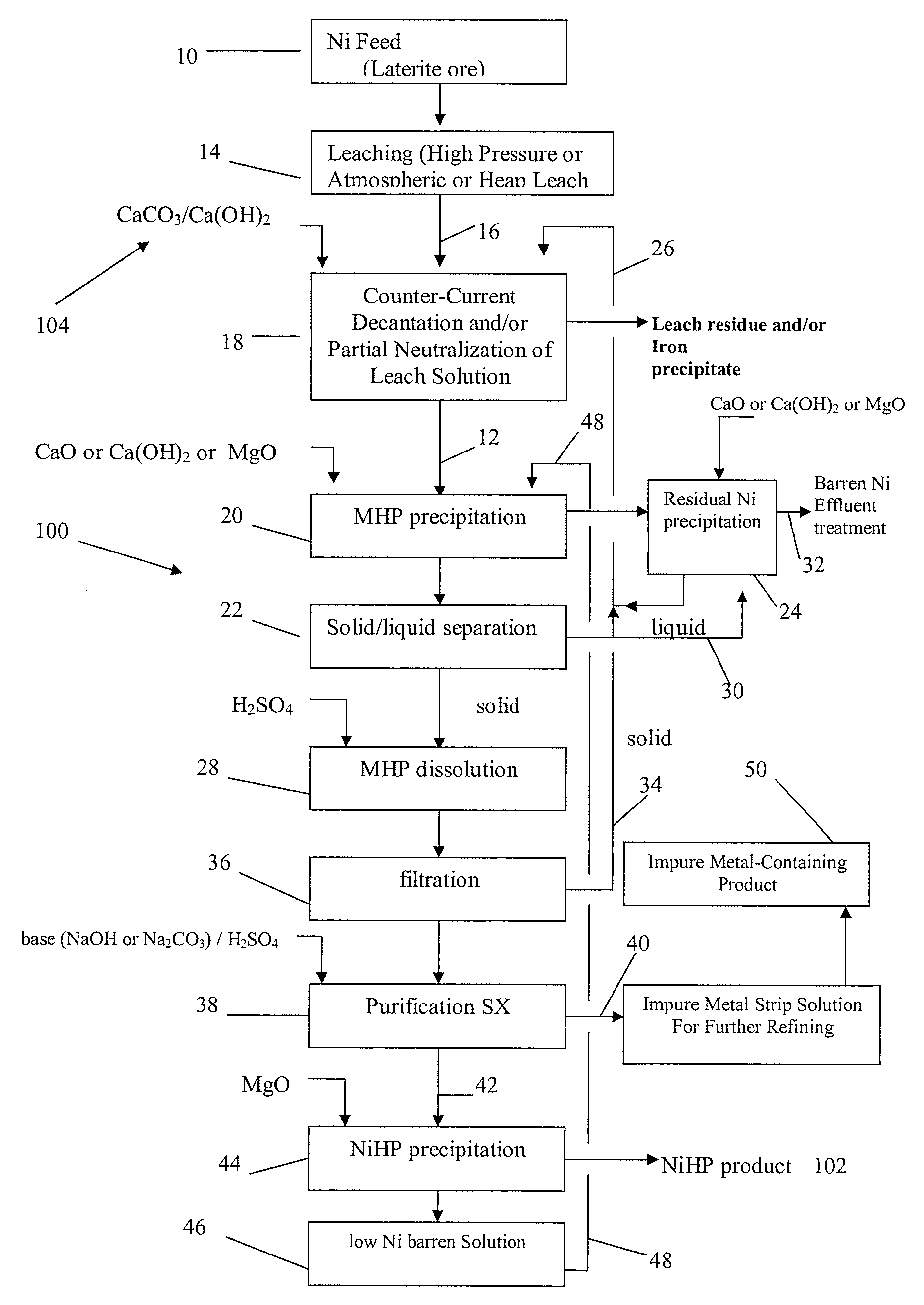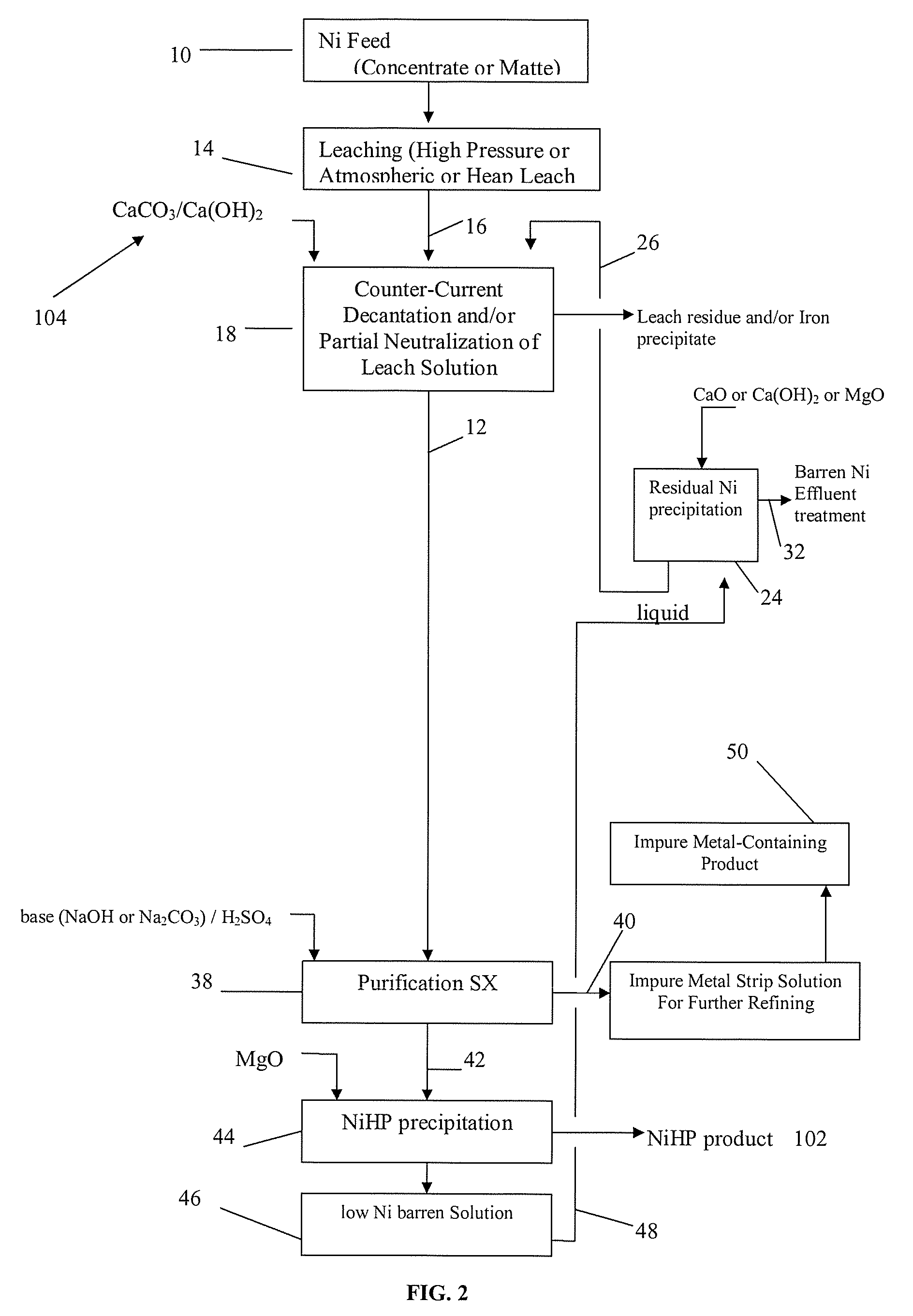Producing nickel hydroxide suitable for pelletization with iron-containing ore and for stainless steel manufacture
a nickel hydroxide and pelletization technology, which is applied in the direction of water/sewage treatment by ion exchange, differential sedimentation, solid separation, etc., can solve the problems of mhp ageing, high capital cost associated with building the necessary h/sub>2 and high capital cost associated with building the necessary h/sub>s plant and associated services
- Summary
- Abstract
- Description
- Claims
- Application Information
AI Technical Summary
Benefits of technology
Problems solved by technology
Method used
Image
Examples
example 1
[0051]This example illustrates, through three separate tests, continuous MHP production using MgO and the effect of MgO dosage on metal precipitation and MHP composition. In this example, the precipitation is carried out under a nitrogen blanket. When compared with the results given in Example 2—tests carried under the same conditions (at 50° C. and same residence time per reactor) and with the same feed solution, however without using a nitrogen blanket—the results illustrate the reduced extent of Mn coprecipitation, thus resulting in an increased Ni:Mn ratio in the product MHP.
EXAMPLE 1Test#123Stoich MgO / (Ni + Co) Ratio:0.850.951.05Average pH in Discharge:7.67.77.8Final Reactor Solution g / lFeed Solution g / lNi4.650.760.430.25Co0.460.020.010.01Ca0.560.610.620.60Mg6.47.98.27.9Mn2.582.322.262.12S13.313.113.112.6Zn0.08MHP Solids %Ni38.336.735.3Co4.274.053.76Ca0.20.20.2Mg2.362.792.70Mn2.993.463.96S5.04.84.6Zn0.820.750.70Ni Extraction %83.990.994.6
example 2
[0052]This example illustrates, through three separate tests, continuous MHP production using MgO and the effect of MgO dosage on metal precipitation and MHP composition. In this example, the precipitation is carried out without a nitrogen blanket. When compared with the results given in Example 1—tests carried under the same conditions and with the same feed solution, however without using a nitrogen blanket—the results illustrate the reduced extent of Mn coprecipitation, thus resulting in an increased Ni:Mn ratio in the product MHP.
EXAMPLE 2Test#789Stoich MgO / (Ni + Co) Ratio:0.850.951.05Average pH in Discharge:7.57.57.7Final Reactor Solution g / lFeed Solution g / lNi4.651.240.840.35Co0.460.040.020.00Ca0.560.580.600.60Mg6.47.68.07.9Mn2.582.222.181.99S13.312.612.812.5Zn0.08MHP Solids %Ni31.636.036.0Co3.874.283.94Ca0.30.10.1Mg2.602.983.32Mn3.074.004.61S4.34.94.9Zn0.750.850.74Ni Extraction %73.782.292.6
example 3
[0053]This example illustrates continuous MHP production using CaO and the beneficial effect of a nitrogen blanketing (tests 1-4 without nitrogen and tests 5-6 with nitrogen blanket). The tests are carried under otherwise the same conditions (at 50° C. and same residence time per reactor) and with the same feed solution. The results illustrate (tests 5 and 6) the reduced extent of Mn coprecipitation, thus resulting in an increased Ni:Mn ratio in the product MHP. Note that tests 2 and 3 are directly comparable (same Ni extraction) to tests 5 and 6, respectively. The Ni:Mn ratio in MHP increases from 5.9 (test 2—no N2) to 11.0 (test 5—with N2) for Ni recovery of 88-89%, and for a nickel recovery of 97-98%, the Ni:Mn ratio in MHP increases from 3.7 (test 3—no N2) to 7.5 (test 6—with N2).
[0054]Tests 1-4 are without nitrogen blanket:
EXAMPLE 3Test #1234pH Control7.27.57.88.1Final Reactor Solution g / lFeed Solution, g / LNi5.651.560.620.110.02Co0.580.180.100.030.01Ca0.550.510.540.500.54Mg24.8...
PUM
| Property | Measurement | Unit |
|---|---|---|
| flash point | aaaaa | aaaaa |
| concentration | aaaaa | aaaaa |
| pH | aaaaa | aaaaa |
Abstract
Description
Claims
Application Information
 Login to View More
Login to View More - R&D
- Intellectual Property
- Life Sciences
- Materials
- Tech Scout
- Unparalleled Data Quality
- Higher Quality Content
- 60% Fewer Hallucinations
Browse by: Latest US Patents, China's latest patents, Technical Efficacy Thesaurus, Application Domain, Technology Topic, Popular Technical Reports.
© 2025 PatSnap. All rights reserved.Legal|Privacy policy|Modern Slavery Act Transparency Statement|Sitemap|About US| Contact US: help@patsnap.com



